Main module
The Particle System module contains global properties that affect the overall system. The main module is expanded by clicking the white icon button to the right of the inspector window.

The name of the module will appear in the inspector as the name of the GameObject that the Particle System component is attached to.
Properties
| Property: | Function: |
|---|---|
| Duration | The length of time the system will run. |
| Looping | If enabled, the system will start again at the end of its duration time and continue to repeat the cycle. |
| Prewarm | If enabled, the system will be initialized as though it had already completed a full cycle (only works if Looping is also enabled). |
| Start Delay | Delay in seconds before the system starts emitting once enabled. |
| Start Lifetime | The initial lifetime for particles. |
| Start Speed | The initial speed of each particle in the appropriate direction. |
| 3D Start Size | Enable this if you want to control the size of each axis seperately. |
| Start Size | The initial size of each particle. |
| 3D Start Rotation | Enable this if you want to control the rotation of each axis seperately. |
| Start Rotation | The initial rotation angle of each particle. |
| Randomize Rotation Direction | Causes some particles to spin in the opposite direction. |
| Start Color | The initial color of each particle. |
| Gravity Modifier | Scales the gravity value set in the physics manager. A value of zero will switch gravity off. |
| Simulation Space | Toggles whether particles are animated in the parent object’s local space (therefore moving with the parent object) or in the world space. |
| Scaling Mode | Use the scale from the transform. Set to Hierarchy, Local or Shape. Local applies only the particle system transform scale. Shape mode applies only the scale to the start position of the particles. |
| Play on Awake | If enabled, the particle system starts automatically when the object is created. |
| Max Particles | The maximum number of particles in the system at once. Older particles will be removed when the limit is reached. |
Property Details
The system emits particles for a specific duration, and can be set to emit continuously using the Looped property. This allows you to set particles to be emitted intermittently or continuously; for example an object may emit smoke in short puffs or in a steady stream.
The “Start” properties (lifetime, speed, size, rotation and color) specify the state of a particle on emission. You can specify a particle’s width, height and depth independently, using the 3D Start Size property (see Non-uniform particle scaling, below).
All particle systems use the same gravity vector specified in the physics settings. The Gravity Multiplier value can be used to scale the gravity, or switch it off if set to zero.
The Inherit Velocity and Simulation Space properties together determine whether the particles move with the Particle System parent object or independently in the game world. For example, systems like clouds, hoses and flamethrowers will need to be set independently of their parent object, as they tend to leave trails that persist in the world space even if the object producing them moves around. On the other hand, if particles are used to create a spark between two electrodes, the particles should move along with the parent object.
Non-uniform particle scaling
The 3D Start Size property allows you to specify a particle’s width, height and depth independently. In the Particle System main module, check the 3D Start Size checkbox, and enter the values for the initial X (width), Y (height) and Z (depth) of the particle. Note that Z (depth) only applies to 3D mesh particles. You can also set randomised values for these properties, in a range between two constants or curves.
You can set the particle’s initial size in the Particle System main module, and its size over the particle’s lifetime using the Separate Axes option in the Size over Lifetime module. You can also set the particle’s size in relation to its speed using the Separate Axes option in the Size by Speed module.